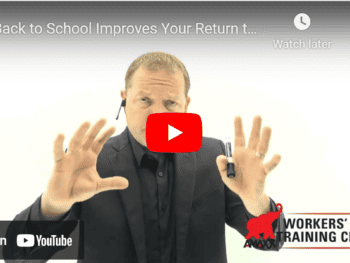
While most in the workers’ compensation world agree with the premise, there are myriad reasons many companies either have no or ineffective Return to Work programs. Small companies may think the money, time and resources involved don’t make financial sense for the number of injuries they typically have, or may be convinced there are just no ‘light duty’ jobs to offer injured workers. Some employers are uncomfortable paying the full salary of a worker who is not at 100 percent capacity. Still others have Return to Work programs in place but can’t see the benefits and let them fall by the wayside.
These ‘legitimate’ sounding reasons are, unfortunately, doing employers a disservice. RTW programs don’t need to involve massive amounts of money or personnel to be effective. There are alternative positions available for injured workers, even in companies without specific light duty jobs. Paying the full salary of a worker who is still recovering can save vast amounts of money compared to the alternative.
Click Link to Access Free PDF Download
“13 Research Studies to Prove Value of Return-to-Work Program & Gain Stakeholder Buy-In”
Why Return to Work
The longer an injured worker is off the job, the more money it costs the employer/insurer. Long durations can even turn into creeping catastrophic claims — a seemingly simple injury that involves multiple medical procedures and medications, and long-term disability.
Various studies have shown that Return to Work programs save money on medical costs, lost time days — including medically unnecessary ones, and workers’ compensation costs. Good programs reduce the duration of claims and the large indemnity costs associated with them. They also cut the number and costs of lawsuits; and wage replacement costs; and productivity losses.
Return to Work programs also helps the injured worker recovery faster. Research clearly shows that, except for the most catastrophically injured, people who are at least somewhat active and engaged recover physically faster than those who are sedentary.
Finally, returning an injured worker in any capacity helps not only lift his spirits, but the morale of his coworkers. It shows the employer cares about them and wants to help them return to work.
Effective Return to Work Program Components
The first order of business in setting up a Return to Work program is to look at the specifics of the company to create a program targeted to its specific needs. See if there are patterns within the company. For example, how many injuries does the company typically have at any given time? Do some facilities have more injuries than others? Do certain jobs have more injuries? Working with managers and supervisors can help.
Benchmark a company’s workers’ compensation stats against others in the industry also can help. Small companies can turn to their insurer or third-party administrator for help.
Supervisors, managers, the insurer or TPA, physicians, and any others should be involved in putting together a Return to Work plan. It should include the following:
- Day 1. Begin the Return to Work process as soon after the injury occurs as possible. Stress that you want to help the injured worker return to work as soon as possible, and make sure others in contact with him continue the message “you are a valued employee and we want you back to work”.
- Communicate the plan. Every employee in the organization should be familiar with the Return to Work plan; whom to call with an injury, what the procedure is, and who has responsibility for different aspects of the post-injury response. Employees should understand that there is a specific, consistent plan in place following any injury and that the goal is returning the person to work. When an injury does occur, provide additional information to the injured worker — such as what to expect, when, and from whom.
- Light duty jobs. Nearly every company has tasks that are consistently put on a back burner; mundane activities that don’t necessarily directly impact the bottom line but could make things easier and more efficient. Injured workers are perfect for those types of tasks, as long as they are within medical restrictions. Engage the injured worker in the discussion, as he might have some thoughts. Working with the insurer, TPA or others within the same field might also trigger some ideas.
If there really is nothing available, consider sending the worker to a nonprofit organization — in states where that is allowed. Doing so will reduce indemnity costs, and help the company’s image in the community.
Once a light duty position is identified, set a deadline for it to end (maximum 120 days) and require regular medical reviews to see when the worker could return to his regular job on either a full- or part-time basis.
- Right providers. Medical vendors are a key part of the Return to Work process, so they must be fully aware of and engaged in it. They need a detailed, accurate job description immediately following an injury. They should focus on what the injured worker is able to do, rather than what he cannot do. And he should be committed to returning the injured worker to work.
In urban areas, there are likely occupational medical providers available. After vetting them, they should be included in the network and spend time learning the company’s culture. In more rural areas, it may be necessary to find and educate nearby physicians.
Conclusion
A Return to Work program is a cost-saver, not a cost driver, and should not be considered a luxury only in good times. A well-thought-out Return to Work plan can save significant dollars for an organization. They just need to be developed, implemented, and maintained.

Author Michael Stack, CEO Amaxx LLC. He is an expert in workers’ compensation cost containment systems and helps employers reduce their workers’ comp costs by 20% to 50%. He works as a consultant to large and mid-market clients, is a co-author of Your Ultimate Guide To Mastering Workers Comp Costs, a comprehensive step-by-step manual of cost containment strategies based on hands-on field experience, and is the founder & lead trainer of Amaxx Workers’ Comp Training Center, which offers the Certified Master of Workers’ Compensation national designation.
Contact: mstack@reduceyourworkerscomp.com.
Workers’ Comp Roundup Blog: http://blog.reduceyourworkerscomp.com/
©2022 Amaxx LLC. All rights reserved under International Copyright Law.
Do not use this information without independent verification. All state laws vary. You should consult with your insurance broker, attorney, or qualified professional.

















